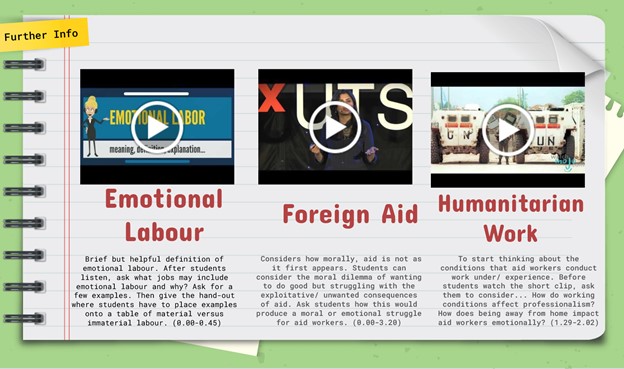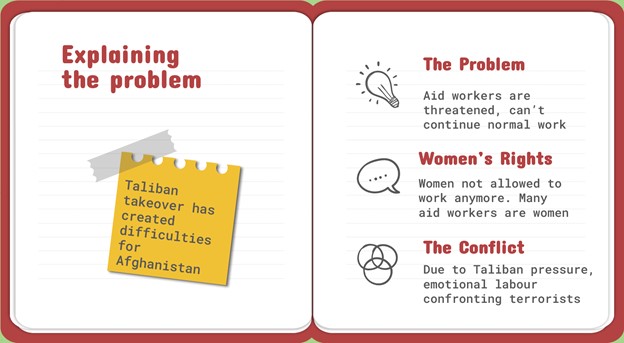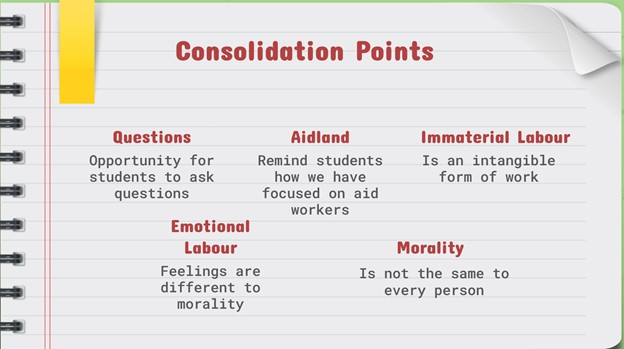(2021-2022) Immaterial labour in ‘Aidland’
Written by Lizzie Cramb, Aniqah Farris, Ros Little, Libby Mercer, Moosa Ma-il Mohamed, Matilda Ponsoby, and Hassan Qureshi.
Disclaimer – Ethics
The situation in Afghanistan may be distressing for students. We hope that this lesson will be navigated with responsibility and sensitivity to prioritise the wellbeing of students to ensure a safe environment and a positive lesson.
Consider that some of the students may have personal relations or experiences with this topic. Trigger warnings can include but are not limited to: violence, war, guns, sexual assault
Aims
(Learning Outcomes):
- Students should be able to summarise the ‘Aidland’ approach
- Students should be able to compare and contrast material labour vs immaterial labour
- Students should address/discuss emotional and moral labour, and confront their differences and consistencies in the context of aid work
Background
The aim of our lesson is for students to look at and understand immaterial labour through the lens of ‘Aidland’. Aidland is an approach coined by Raymond Apthrope (2005) that focuses on the lives, motivations, and professional work of the aid workers themselves, rather than the aid recipients or governments, and policies that distribute and manage aid. It takes into account that aid workers may be detached from the reality in which they are working and perceive their actions differently from what the consequences suggest, and thus allows us an insight into the ways that aid workers organise and understand their own lives and worlds (Mosse, 2011). This approach is beneficial as it helps us understand the unintended consequences that derive from everyday practices of aid workers, rather than from bureaucratic means or systematic failure, and allows us to maintain a level of critique while exploring the ethical motivations of aid workers. By looking at immaterial labour vs material labour and ideas of moral and emotional labour through this lens, we can explore the motivations behind aid work from the perspective of the workers themselves.
Requirements
Target number of students = 30
Space to split students into a small and large group
Resources
- Handouts provided by us, addressing and explaining the Aidland approach and immaterial labour so pupils can refer to it throughout the lesson;
- Sticky notes for activity 1;
- A powerpoint presentation;
- 3 videos to show to the class.
Explaining the Main Topics
Time taken: 7 mins
Resources: What is Aidland (handout) + Videos for context (timestamps on presentation)
This is how it will be explained to students

Main topics:
Aidland = Explain to students that Aidland is an anthropological approach that focuses on the experiences of professionals who work within aid organisations. Use the analogy of Alice in Wonderland to explain that ‘Aidland’ comes from the idea that aid workers can be detached from the realities they work in and don’t always understand the consequences they bring around in their everyday practices.
- “Strangely late and reluctantly, anthropologists have turned to the study of the social and cultural lives of global professionals themselves, their class position, biographies, commitments and anxieties” – Mosse 2011
Immaterial Labour = Explain to students that part of the labour performed by aid professionals does not produce tangible products or reveal itself in physical ways (Fechter 2016, p.231). We also see how aid workers engage in moral and emotional labour which don’t necessarily create concrete outcomes as material labour would.
Learning outcome achieved: 1
2 ACTIVITIES
ACTIVITY 1: SORTING OUT LABOUR
Time taken: 5 mins
Resources: Sticky notes- Various kinds of jobs (physical and immaterial)
PREP (2 mins)
- Students will be split into 5 small groups of 6
- Students will be handed out sticky notes with examples of material and immaterial jobs, as well as brief scenarios (e.g. “making burgers at McDonalds”)
SORTING (3 mins)
- Students will be asked to identify whether the notes represent material labour or immaterial labour
- Once completed, discuss the decisions with the students to see if they were correct.
Students will be allowed to refer to the handout on immaterial labour to help them.
Allocated time is limited to encourage students to not think too deeply on each job, allowing teachers to challenge their assumptions during the discussion
Learning outcome achieved: 2
ACTIVITY 2: DISCUSSION

Time taken: 5 minutes prep + 10 mins discussion
Resources: Discussion: What is immaterial labour? (handout), Afghanistan article (link in presentation)
PREP (5mins):
- Students will be told of the situation in Afghanistan (See slide 14 above)
- Students will split into 2 groups: one discussing emotional labour one discussing moral labour
- Each group received either the explanation of emotional labour or moral labour:
Moral Labour: Morality drives practices of “doing good”. It is socially constructed and acted upon – there is no universal moral. It involves doing immaterial labour based on what is thought to be “right”.
Emotional Labour: the use or production of emotions in labour. For example, portraying yourself as happy when working in customer service. This does NOT relate to what is “good” or “right” = you can perform emotional labour to meet an end which is not moral.
DISCUSSION (10mins):
- Each group explains the definition to the other, creating incentive for understanding the concepts(Teachers be ready to guide with this)
- Students will be asked “What would you do if you were an aid worker in Afghanistan? In response, each group will brainstorm their emotions / moral conflicts that arise when asking themselves “What would I do if I was an aid worker in Afghanistan?”
- Students present ideas to each other
- Note for teacher (to share with the class): Theories of gender suggest that women are associated with roles involving emotional labour; which could be relevant in the fact that seven in eight aid directors residing in Afghanistan are women (Gall, The New York Times, 2021).
- Fechter references Hochschild’s assertion that ‘although emotional labour may be required by both female and male service workers, such expectations are particularly pronounced for women’ (Fechter 2016, p.231). This mirrors the gendered emotion versus reason binary, as applied to women/minority genders (emotional) and to men (reasoning).
- This may therefore be an opportunity to prompt the class to be self-reflective when it comes to constructing their moral arguments – would your gender influence your role as an aid worker? Does your gender influence the ways in which you negotiate your emotions when making decisions?
Learning outcome achieved: 3
CONSOLIDATION
Time taken: Last 3 minutes
- Q&A session and final ideas shared
- This is the opportunity for the teacher to reinforce / remind the concepts of AIDLAND, IMMATERIAL LABOUR, EMOTIONAL LABOUR and MORAL LABOUR (see slides)

Bibliography
- Apthorpe, R. (2005), Postcards from Aidland, Or: Love from Bubbleland. Paper presented at a graduate seminar at IDS, University of Sussex
- Fechter, A-M. (2016), ‘Aid work as moral labour’, Critique of Anthropology, 36(3), pp. 228–243.
- Gall, C. (2021), Aid Workers Staying in Taliban-Ruled Afghanistan Tread a Tricky Path https://www.nytimes.com/2021/09/08/world/asia/afghanistan-aid-workers-taliban.html New York Times, accessed 22/11/2021
- Harrison, E. (2013), ‘Beyond the looking glass? ‘Aidland’ reconsidered’, Critique of Anthropology, 33(3), pp. 263–279.
- Hochschild, A.R. (2012), The managed heart : commercialization of human feeling . Updated edition. Berkeley, Calif. ;: University of California Press.
- Mosse, D. (ed) (2011), Adventures in Aidland: The Anthropology of Professionals in International Development. Oxford: Berghahn Books, pp. 1–32.
- NHS Digital, (2020), New report from NHS Digital shows sharp increase in children experiencing mental health difficulties https://www.place2be.org.uk/about-us/news-and-blogs/2020/october/new-report-from-nhs-digital-shows-sharp-increase-in-children-experiencing-mental-health-difficulties/ accessed 24/11/2021
Additional Reading:
- Denskus, T. and Papan, AS. (2013), Reflexive engagements: The international development blogging evolution and its challenges. Development in Practice 23(4): 435–447
- Hardt, M. and Negri, A. (2004), Multitude: War and Democracy in the Age of Empire. New York, NY: Penguin.
- Wintour, P. (2021), Taliban seeks to reassure UN over aid workers’ safety in Afghanistan, https://www.irishtimes.com/news/world/asia-pacific/taliban-seeks-to-reassure-un-over-aid-workers-safety-in-afghanistan-1.4672947 Irish Times, accessed 22/11/2021

0 Comments